
Welcome to the inaugural voyage of the World Wine Travel group! Started – and hosted this month – by Jeff of FoodWineClick, we’ll spend 2021 visiting the wine regions of Spain, exploring their culture and cuisine. Of course we’ll also taste some really fabulous wines!
Going forward, we’ll gather on Twitter the fourth Saturday of each month to share our tasting notes, food pairings, and travel tales. January’s topic is Rioja (read Jeff’s invitation post here), and we’ll be chatting at 11 am ET on January 23rd. Follow the hashtag #worldwinetravel and add your comments. All are welcome.
Scroll to the bottom of this post to see what each of the participants will add to the convo.
In a Sea of Red Wine, White Rioja Stands Out
Given that white wine comprises just 10% of production in Rioja, it’s not surprising that these wines are less well-known. Such a shame, really, as they come in a range of styles: from youthful, fruit-forward wines to complex oak-aged examples, these wines are deserving of our attention. On occasion they warrant contemplation.
For Immediate Enjoyment: Joven Wines
These wines are no more than 15 months old and have no oak influence: they’re fermented in stainless steel vats under cool conditions, with the goal of preserving the fruit’s primary aromas. Not the traditional way of producing Rioja Blanco (more on that in a moment) this style was more of an adaptation of the methods used to great success in Rías Baixas (Albariño) and Rueda (Verdejo). What’s in the bottle is fresh and light, full of citrus and orchard fruit. They make great apéritifs and pair well with lighter dishes. As they’re less expensive to make (no barrels; no time spent aging in the cellar) these wines are approachable and very easy to like.

A perfect example of this style is CVNE’s Monopole.
CVNE stands for Compañía Vinícola del Norte de España, and was established in 1879 by brothers Eusebio and Raimondo Real de Asúa. The fifth generation runs the enterprise today, including 1,350 acres of vineyards directly owned by the family and which account for 50% of CVNE’s production.
The 2019 Monopole is pale lemon-green with aromas of white flowers, apple, pear, and hay. On the palate it is lemony, with flavors of green apple; medium+ acidity. The finish is moderate in length and has a tempting savory quality to it. Really delicious and drinks way above its modest price tag.
For the Patient Wine Lover: Oak-Aged, Golden Delights
According to Eric Asimov of the New York Times, “Good white Rioja is not so much about fruit as it is about the absence of it.” That’s quite a statement but, after having tasted two wines from López de Heredia, I completely understand it.
White Rioja was traditionally made from a Viura-dominant blend, with support from Garnacha Blanca and Malvasía Riojana. A few other Spanish grapes (Tempranillo Blanco, Maturana Blanco, and Turruntés de Rioja) were permitted but seldom used. In 2007 the Consejo Regulador added Chardonnay, Sauvignon Blanc, and Verdejo to the mix, allowing varietal wines to be made from these grapes as of 2017.
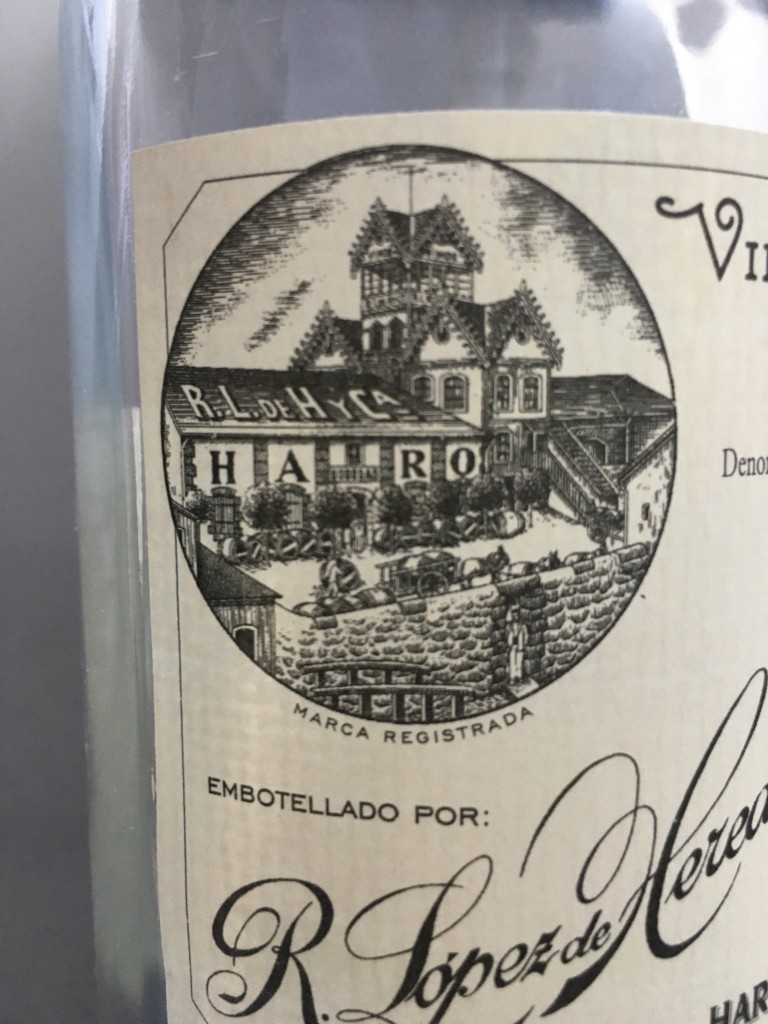
In the 1970s, these wines would come from fruit of old vines planted in poor, rocky soils. Viura, a high-acid, neutral grape would be blended with Malvasía Riojana, a variety prone to oxidation and one that would soften Viura’s acidity and contribute color. Skin contact before or during fermentation (often in barrel) was not uncommon. Winemakers typically used native yeasts, allowed malolactic conversion to take place, and allowed the wine to rest on its lees, with regular bâtonnage.
Classic Rioja Blanco aged for extended periods in neutral oak, allowing the slow development of tertiary aromas and flavors, and concentrating the wine’s color to a deep gold. After bottling, it aged further in the winery’s cellar until deemed ready for release.
I recently tasted two such wines, both from esteemed producer R. López de Heredia.
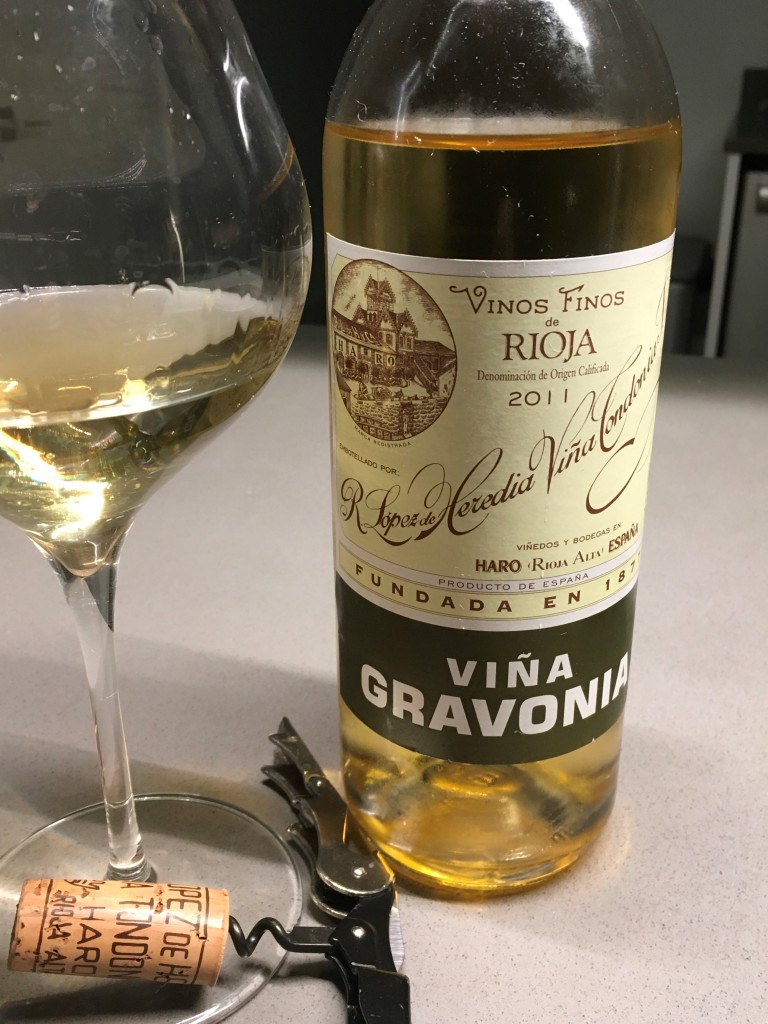
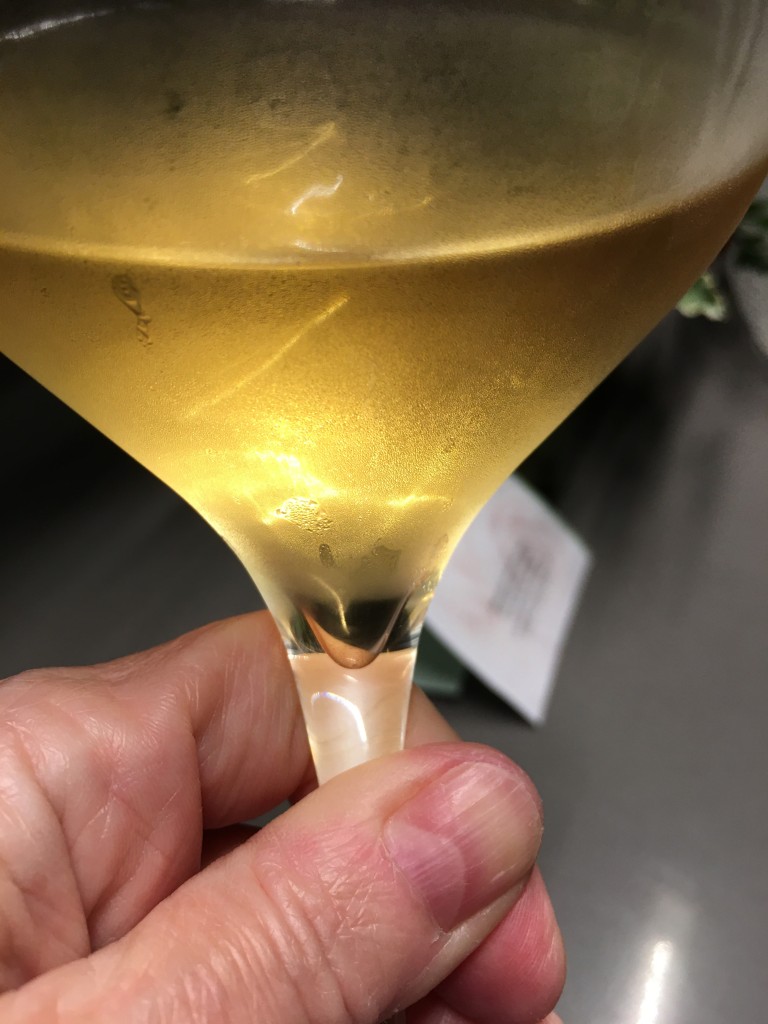
2011 R. López de Heredia Viña Gravonia Crianza
100% Viura, this wine has a gorgeous deep yellow-gold robe, testament to the four years it spent in barrel, with twice-per-year rackings. It was fined with fresh egg whites but was not filtered. Aromas of dried citrus peel (lemon, orange, grapefruit) and herbs; a hint of mushroom; and a nutty combination of almond and hazelnut. On the palate it was lively, with medium+ acidity, candied lemon, marzipan, and a savory-caramel-like sensation that lasted forever on the finish. A gorgeous wine, and a wonderful welcome into the world of aged white Rioja.
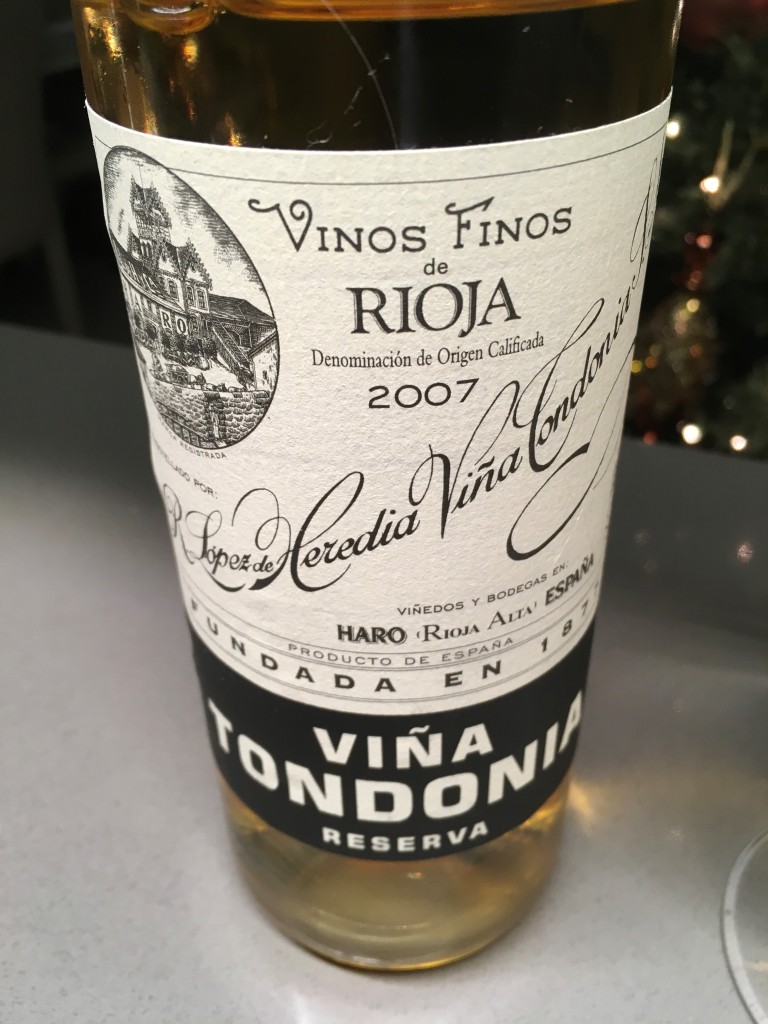
2007 R. López de Heredia Viña Tondonia Reserva
90% Viura and 10% Malvasía Riojana, this wine was fermented in oak without skin contact. It aged for six years in barrel, with twice-yearly rackings. As with the Gravonia, it was fined with egg whites but not filtered. A bit deeper in color than the first wine (all gold!) it also had more pronounced tertiary aromas and flavors – especially upon uncorking. Dried fruit, slate-like minerality, forest floor, almonds – the aromas kept evolving as the hours passed by. Even two days after opening, this wine kept popping up new things to smell and taste.

The palate was similar to the Gravonia but just, well, more. This wine was extra in all the good ways. I was amazed at how complex it was, how generous it was: I’m now an avowed devotée of aged white Rioja wines.
A Little Taste of Both Worlds
For those whose palates crave a fruit-forward wine with a bit of added complexity, but who perhaps aren’t quite ready to dive into full-on tertiary territory, there are wines that have elements of both.
Most of these wines are fermented in barrels – for a hint of oak influence – but are not aged for long periods of time. There is no oxidative character, no deep gold color. CVNE makes a special version of its Monopole wine, called Monopole Barrel Ferment. I haven’t tasted it but imagine it’s similar to the wine I described earlier but with a rounder texture and some secondary aromas from the time in barrel.
What I did taste was a wine that, in my opinion, truly occupies the middle ground between modern-day Rioja Blanco and the old-school, classic wines: CVNE’s Monopole Clásico.
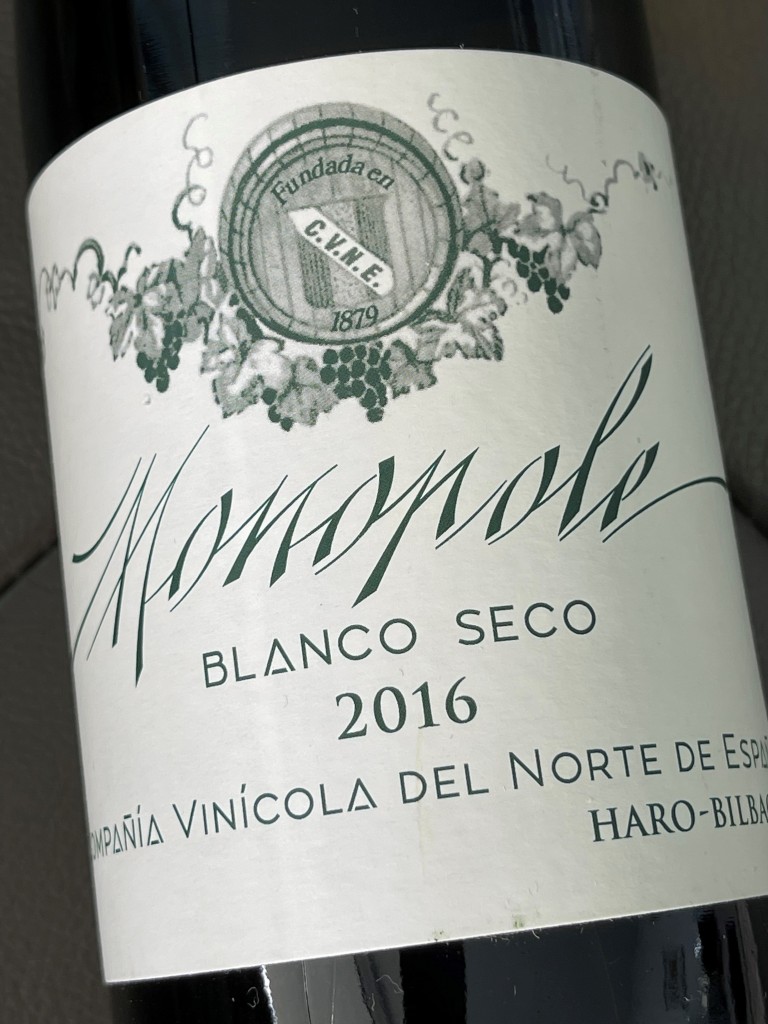
Monopole was first produced in 1915, making it the oldest white wine brand in Spain. It is made much differently today than it was originally: today the free-run juice is fermented in temperature-controlled stainless steel vats for a fruity, fresh wine that is ready to drink. At its inception, Monopole was barrel-aged in Manzanilla Sherry casks that held a bit of residual wine. The resulting wine was rich, with a hint of yeasty flor character, a style that remained popular until the 1980s, when consumer tastes turned toward unoaked, fruit-forward wines.

CVNE still makes a version of Monopole that pays tribute to the original wine. It’s called Monopole Clásico, and is aged in barrels, as per tradition, with a small quantity of Manzanilla Sherry. Grapes are fermented in stainless steel vats at low temperatures; the wine is then transferred to large, used oak barrels, when the aged Manzanilla sherry is added.
Note: this would usually be a violation of Consejo Regulador rules for Rioja production. But, because the original wine was made in this fashion, CVNE received a dispensation allowing them to continue the process.

How did it smell/taste? While not as complex as the López de Heredia wines, this one still had plenty to say. Less tertiary character but a step up from the primary fruit focus of the Joven wine, this Monopole Clásico offered bewitching aromas of beeswax, dried apple and pear, almond paste, and citrus zest. On the palate it was still quite fruity, very pleasant and approachable; but the finish hinted at its classic origins and the tiny bit of Manzanilla added to barrel. It in no way tastes like Sherry but there was a little saline/umami note that pumped the experience up a notch. I loved the one-foot-in-both-worlds personality of this wine. It was delicious and mysterious; a wine trip I’d like to take again.
My Take-Away
Rioja Blanco is an underappreciated treasure. The fresh, young wines are a pleasure to drink and won’t bust the budget. The longer-aged, traditional style wines are remarkably complex and worthy of exploration. And where else can you buy a high-quality, barrel-aged wine from one of the old world´s classic regions for around $50? I, for one, will be continuing this research project!
Here’s what the rest of the World Wine Travel bloggers are posting today:
- Andrea at The Quirky Cork shares “Marqués de Cáceres Crianza with Chorizo Sweet Potato Pockets“
- Wendy at A Day in the Life on the Farm shares “Mexican Ham Soup and a Spanish Rioja Wine“
- Camilla at Culinary Adventures with Camilla shares “Catalan Coques + La Rioja Alta Viña Arana Rioja Gran Reserva 2014“
- Steve at Children of the Grape shares “Tasting Rioja With Aging Eyes“
- Allison and Chris at Advinetures share “Rioja: The Confluence of Tradition & Modernity“
- Robin at Crushed Grape Chronicles shares “Viura – There is more to Rioja than Tempranillo“
- David at Cooking Chat shares “White Bean Stew with Sausage and a Rioja“
- Lynn at Savor the Harvest shares “Revisiting Rioja: Vinedos Singulares with Bodegas Ontañon”
- Nicole at Somms Table shares “One Day in Haro“
- Lauren at The Swirling Dervish shares “White Rioja: There’s a Style for Every Palate“
- Linda at My Full Wine Glass shares “Classic Rioja Alta to kick off virtual trip to Spain“
- Terri at Our Good Life shares “Our First Rioja with Assorted Easy Tapas“
- Marcia at Joy of Wine shares “White Rioja: Taste and See What You’re Missing”
- Susannah at Avvinare shares “Exploring Legendary Winery Marqués de Riscal”
- Gwendolyn at Wine Predator shares “Regional Rioja: Tempranillo, Viura, Rosado paired with hearty soup, salad, lamb, patatas bravas”
- Martin at Enofylz shares “Reconsidering Rioja Blanco with the 2008 R. López de Heredia Rioja Blanco Reserva Viña Tondonia“
- Jeff at Food Wine Click! shares “Rioja Oriental – A Cinderella Story“
References for this Post:
R. López de Heredia Viña Tondonia, S.A. (lopezdeheredia.com)
Amazing White Rioja Wines | Wine Folly
White Rioja: Great value wines to try – Decanter expert guide
White Rioja – an underrated classic? | Quentin Sadler’s Wine Page (wordpress.com)
Wine Store | Wine Importer | Wine Distributor – Rare Wine Co. Interview with Maria de Lopez de Heredia
López de Heredia Rioja – Rare Wine Co.
The New White Rioja: Progress or Perdition? : Vinography
Monople Clásico, the return of a Spanish classic | Quentin Sadler’s Wine Page (wordpress.com)
Castillo Ygay White 1986 | Marqués de Murrieta (marquesdemurrieta.com)
[…] Lauren at The Swirling Dervish shares “White Rioja: There’s a Style for Every Palate” […]
LikeLike
We’re delighted to see you shine a light on white wines from Rioja. We love the reds but our very first visit to the region opened our eyes to them and we’ve never looked back. Still (in our humble opinions) underrated and undervalued and always surprise guests when we serve them.
LikeLiked by 1 person
This was my first deep dive into the subject and I was blown away. So much more to discover!
LikeLiked by 1 person
Great pairings. I am intrigued by all the white wines being showcased today.
LikeLiked by 1 person
I’m with you on that. White wines aren’t the first thing we think of when we hear Rioja, but maybe they should be. 🙂
LikeLike
[…] Lauren at The Swirling Dervish shares “White Rioja: There’s a Style for Every Palate“ […]
LikeLike
[…] at The Swirling Dervish shares “White Rioja: There’s a Style for Every […]
LikeLike
I know so little about white Rioja and I’ve never had the opportunity to try one but your descriptions are so amazing that I both feel like I tasted them vicariously and am even more anxious to try one myself!
LikeLiked by 1 person
Have to admit my experience with them was limited until recently. I will definitely be drinking more white Rioja going forward!
LikeLike
I [blush, blush] had never heard of a White Rioja until today’s event. So much to learn. Thanks for sharing and I am now on the hunt for the wines.
LikeLiked by 1 person
Until recently I hadn’t tasted many of them either. Definitely plan to change that!
LikeLike
That’s a lot of white Rioja in one night…and good ones too! 😉 Like the whites of Burgundy and Bordeaux, I’m rather fond of the white from Rioja also! Thanks for sharing!
LikeLiked by 1 person
Tasted these over the course of a month but I’d love to do a side-by-side tasting of all four at once! And maybe adding a few others to the mix 🙂
LikeLiked by 1 person
What an amazing dive into White Rioja! I learned so much from this piece! I tastedd one of those in between wines, barrel femented with limited aging. I now understand more of it’s place in White Rioja. Great piece!
LikeLiked by 1 person
Thanks Robin. This even was a great chance for me to learn more about wines I wasn’t really familiar with. I plan to try many more of them!
LikeLiked by 1 person
[…] Lauren at The Swirling Dervish says White Rioja: There’s a Style for Every Palate. […]
LikeLike
“In a Sea of Red Wine, White Rioja Stands Out”– so true! Viura is my new crush! Your post is very informative — I’m ready to take a deep dive too!
LikeLiked by 1 person
Thanks Gwendolyn! This was such an enlightening and delicious topic; can’t wait to taste more of these wines.
LikeLiked by 1 person
Hadn’t heard of Monopole Clásico wine with sherry, gosh I’d love to taste it! And that they received dispensation to continue making it… reminds me of the Slow Food Ark of Taste. If it’s not already on it, it should be! Super article Lauren!
LikeLiked by 1 person
Thanks so much! I had read about the Clasico a while back and finally bought a bottle to taste. I enjoyed it as much as the history behind it. Can’t wait to go back to Spain!
LikeLike
What a great look at Rioja white wines! So underappreciated and these are excellent examples of the range of styles. I hadn’t seen the Monopole classico, and now am very intrigued and will have to keep an eye out!
LikeLiked by 1 person
Thanks! I had been wanting to try it for a while, finally got one to taste. This month’s event really has me craving a trip to Rioja – maybe one day!
LikeLike
[…] Lauren at The Swirling Dervish shares “White Rioja: There’s a Style for Every Palate“ […]
LikeLike
I feel like my eyes have been opened up to the world of white Rioja. In the textbooks, the whites of this region are glossed over. You’ve shown, Lauren, that they are worthy of a deep dive. Hoping to take my own plunge sometime soon. Thanks for a great post!
LikeLiked by 1 person
Thanks Linda. I hope you’re able to try them. I’ve glossed over these wines for years, never tasting an oak-aged white Rioja until a few months ago. Now I’m smitten, and my research will continue.
LikeLike
Wow! You really showed out on Rioja Whites Lauren! I’ve got a bottle of that Cune Monopole you’ve inspired me to get to sooner rather than later. Your description of the Rioja Blancos as an underappreciated treasure is spot on! Great pairings too! Cheers!
LikeLiked by 1 person
Thanks so much, Martin. This month’s event spurred me to learn more about Rioja Blanco and I feel like I’m just getting started. More to come!
LikeLike